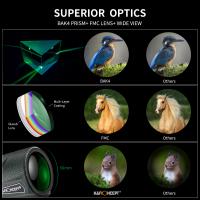Microscopes How They Work ?
Microscopes work by using lenses to magnify small objects or organisms that are too small to be seen with the naked eye. There are two main types of microscopes: light microscopes and electron microscopes.
Light microscopes use visible light to illuminate the specimen and magnify it. The light passes through the specimen and is refracted by the lenses in the microscope, which magnify the image and project it onto the eyepiece or camera. Light microscopes can magnify objects up to 1000 times their original size.
Electron microscopes use a beam of electrons instead of light to magnify the specimen. The electrons are focused by magnetic lenses and directed onto the specimen, which is coated with a thin layer of metal to make it conductive. The electrons interact with the atoms in the specimen, producing an image that is magnified and projected onto a screen or camera. Electron microscopes can magnify objects up to 10 million times their original size.
Both types of microscopes have different applications and are used in various fields such as biology, medicine, materials science, and nanotechnology.
1、 Optical Microscopes
Optical microscopes, also known as light microscopes, use visible light and lenses to magnify small objects. The basic principle of an optical microscope is to focus light through a sample and then magnify the image using a series of lenses. The sample is placed on a glass slide and illuminated from below with a light source. The light passes through the sample and is then focused by the objective lens, which is located just above the sample. The magnified image is then viewed through the eyepiece.
The resolution of an optical microscope is limited by the wavelength of visible light, which is around 400-700 nanometers. This means that objects smaller than this cannot be resolved. However, advances in technology have led to the development of techniques such as confocal microscopy and super-resolution microscopy, which can overcome this limitation and achieve higher resolution.
Confocal microscopy uses a laser to scan the sample and create a 3D image. This technique allows for the visualization of structures within a sample at a higher resolution than traditional optical microscopy.
Super-resolution microscopy, on the other hand, uses fluorescent molecules to achieve a resolution beyond the diffraction limit of visible light. This technique has revolutionized the field of microscopy, allowing for the visualization of structures at the nanoscale level.
In conclusion, optical microscopes work by using visible light and lenses to magnify small objects. While the resolution of traditional optical microscopy is limited by the wavelength of visible light, advances in technology have led to the development of techniques such as confocal microscopy and super-resolution microscopy, which can achieve higher resolution and provide new insights into the world of the small.
2、 Electron Microscopes
Electron microscopes are powerful tools used to study the structure and properties of materials at the atomic and molecular level. Unlike optical microscopes, which use visible light to magnify objects, electron microscopes use a beam of electrons to create an image. This allows for much higher magnification and resolution, making it possible to see details that are too small to be seen with an optical microscope.
Electron microscopes work by using a beam of electrons that is focused onto the sample being studied. The electrons interact with the atoms in the sample, producing signals that can be detected and used to create an image. There are two main types of electron microscopes: transmission electron microscopes (TEM) and scanning electron microscopes (SEM).
TEMs work by passing a beam of electrons through a thin sample, which is mounted on a grid. The electrons that pass through the sample are then focused onto a screen or detector, creating an image of the sample's internal structure. SEMs, on the other hand, work by scanning a beam of electrons across the surface of a sample, producing a three-dimensional image of its surface structure.
Recent advances in electron microscopy have led to the development of new techniques, such as cryo-electron microscopy (cryo-EM), which allows for the study of biological molecules and complexes in their native state. Cryo-EM involves freezing samples in liquid nitrogen, which preserves their structure and allows for high-resolution imaging.
In conclusion, electron microscopes are powerful tools that have revolutionized our understanding of the world around us. With continued advances in technology, electron microscopy will continue to play a critical role in scientific research and discovery.
3、 Magnification and Resolution
Magnification and Resolution are the two key factors that determine the effectiveness of microscopes. Magnification refers to the ability of a microscope to enlarge an object, while resolution refers to the ability to distinguish between two closely spaced objects.
Microscopes work by using lenses to bend and focus light, allowing us to see objects that are too small to be seen with the naked eye. The magnification of a microscope is determined by the combination of lenses used in the system. The eyepiece lens and objective lens work together to magnify the image of the specimen. The higher the magnification, the greater the level of detail that can be seen.
Resolution, on the other hand, is determined by the quality of the lenses and the wavelength of light used. The shorter the wavelength of light, the higher the resolution. This is why electron microscopes, which use electrons instead of light, have much higher resolution than traditional light microscopes.
In recent years, advancements in technology have led to the development of new types of microscopes, such as super-resolution microscopes, which can achieve resolutions beyond the diffraction limit of light. These microscopes use techniques such as stimulated emission depletion (STED) and structured illumination microscopy (SIM) to achieve resolutions of a few nanometers.
In conclusion, microscopes work by using lenses to magnify and focus light, allowing us to see objects that are too small to be seen with the naked eye. Magnification and resolution are the two key factors that determine the effectiveness of microscopes, and recent advancements in technology have led to the development of new types of microscopes with even higher resolutions.
4、 Illumination and Contrast
Illumination and Contrast are two critical factors in understanding how microscopes work. Illumination refers to the light source used to illuminate the specimen being viewed. Contrast, on the other hand, refers to the difference in brightness between the specimen and its background.
In a microscope, the light source is typically located at the base of the instrument and shines up through the specimen. The light passes through a series of lenses, including the objective lens, which magnifies the image. The quality of the illumination is crucial in determining the clarity and detail of the image.
Contrast is also essential in microscopy. Without proper contrast, the specimen may blend into the background, making it difficult to distinguish important features. There are several techniques used to enhance contrast, including staining, phase contrast, and differential interference contrast.
In recent years, advancements in microscopy technology have led to the development of new techniques, such as super-resolution microscopy, which allows for the visualization of structures smaller than the diffraction limit of light. Additionally, the use of fluorescent dyes and proteins has revolutionized the field of microscopy, allowing for the visualization of specific molecules and cellular processes in real-time.
In conclusion, illumination and contrast are fundamental concepts in understanding how microscopes work. The quality of the illumination and contrast can significantly impact the clarity and detail of the image. With the latest advancements in microscopy technology, researchers can now visualize structures and processes at the molecular level, leading to new discoveries and advancements in various fields, including medicine, biology, and materials science.






































There are no comments for this blog.